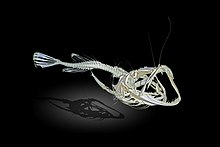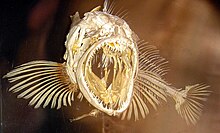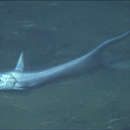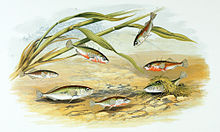Actinopterygii (/ˌæktɪnɒptəˈrɪdʒiaɪ/; from actino- 'having rays', and Ancient Greek πτέρυξ (ptérux) 'wing, fins'), members of which are known as ray-finned fishes, is a class of bony fish.[2] They comprise over 50% of living vertebrate species.[3]
The ray-finned fishes are so called because their fins are webs of skin supported by bony or horny spines (rays), as opposed to the fleshy, lobed fins that characterize the class Sarcopterygii (lobe-finned fish). These actinopterygian fin rays attach directly to the proximal or basal skeletal elements, the radials, which represent the link or connection between these fins and the internal skeleton (e.g., pelvic and pectoral girdles).
By species count, actinopterygians dominate the vertebrates, and they constitute nearly 99% of the over 30,000 species of fish.[4] They are ubiquitous throughout freshwater and marine environments from the deep sea to the highest mountain streams. Extant species can range in size from Paedocypris, at 8 mm (0.3 in), to the massive ocean sunfish, at 2,300 kg (5,070 lb), and the long-bodied oarfish, at 11 m (36 ft). The vast majority of Actinopterygii (~99%) are teleosts.
Characteristics

Anatomy of a typical ray-finned fish (
cichlid)
:
dorsal fin,
B:
fin rays,
C:
lateral line,
D: kidney,
E:
swim bladder,
F:
Weberian apparatus,
G:
inner ear,
H: brain,
I: nostrils,
L: eye,
M:
gills,
N: heart,
O: stomach,
P: gall bladder,
Q: spleen,
R: internal sex organs (ovaries or testes),
S:
ventral fins,
T: spine,
U:
anal fin,
V: tail (
caudal fin). Possible other parts not shown:
barbels,
adipose fin, external genitalia (
gonopodium)
Ray-finned fishes occur in many variant forms. The main features of typical ray-finned fish are shown in the adjacent diagram. The swim bladder is a more derived structure than the lung.[5]
Ray-finned fishes have many different types of scales; but all teleosts have leptoid scales. The outer part of these scales fan out with bony ridges, while the inner part is crossed with fibrous connective tissue. Leptoid scales are thinner and more transparent than other types of scales, and lack the hardened enamel or dentine-like layers found in the scales of many other fish. Unlike ganoid scales, which are found in non-teleost actinopterygians, new scales are added in concentric layers as the fish grows.[6]
Ray-finned and lobe-finned fishes sometimes possesses lungs used for aerial respiration. Only bichirs retain ventrally budding lungs.[5]
Body shapes and fin arrangements
Ray-finned fish vary in size and shape, in their feeding specializations, and in the number and arrangement of their ray-fins.
The swordfish is even faster and more streamlined than the tuna
Salmon generate enough thrust with their tail fin to jump obstacles during river migrations
Fangtooth are indifferent swimmers who try to ambush their prey
The first spine of the dorsal fin of anglerfish is modified like a fishing rod with a lure
Bichirs are the most basal living ray-fins; they possess lungs
Reproduction
In nearly all ray-finned fish, the sexes are separate, and in most species the females spawn eggs that are fertilized externally, typically with the male inseminating the eggs after they are laid. Development then proceeds with a free-swimming larval stage.[7] However other patterns of ontogeny exist, with one of the commonest being sequential hermaphroditism. In most cases this involves protogyny, fish starting life as females and converting to males at some stage, triggered by some internal or external factor. Protandry, where a fish converts from male to female, is much less common than protogyny.[8]
Most families use external rather than internal fertilization.[9] Of the oviparous teleosts, most (79%) do not provide parental care.[10] Viviparity, ovoviviparity, or some form of parental care for eggs, whether by the male, the female, or both parents is seen in a significant fraction (21%) of the 422 teleost families; no care is likely the ancestral condition.[10] The oldest case of viviparity in ray-finned fish is found in Middle Triassic species of †Saurichthys.[11] Viviparity is relatively rare and is found in about 6% of living teleost species; male care is far more common than female care.[10][12] Male territoriality "preadapts" a species for evolving male parental care.[13][14]
There are a few examples of fish that self-fertilise. The mangrove rivulus is an amphibious, simultaneous hermaphrodite, producing both eggs and spawn and having internal fertilisation. This mode of reproduction may be related to the fish's habit of spending long periods out of water in the mangrove forests it inhabits. Males are occasionally produced at temperatures below 19 °C (66 °F) and can fertilise eggs that are then spawned by the female. This maintains genetic variability in a species that is otherwise highly inbred.[15]
Classification and fossil record
Actinopterygii is divided into the classes Cladistia and Actinopteri. The latter comprises the subclasses Chondrostei and Neopterygii. The Neopterygii, in turn, is divided into the infraclasses Holostei and Teleostei. During the Mesozoic (Triassic, Jurassic, Cretaceous) and Cenozoic the teleosts in particular diversified widely. As a result, 96% of living fish species are teleosts (40% of all fish species belong to the teleost subgroup Acanthomorpha), while all other groups of actinopterygians represent depauperate lineages.[16]
The classification of ray-finned fishes can be summarized as follows:
- Cladistia, which include bichirs and reedfish
- Actinopteri, which include:
- Chondrostei, which include Acipenseriformes (paddlefishes and sturgeons)
- Neopterygii, which include:
- Teleostei (most living fishes)
- Holostei, which include:
- Lepisosteiformes (gars)
- Amiiformes (bowfin)
The cladogram below shows the main clades of living actinopterygians and their evolutionary relationships to other extant groups of fishes and the four-limbed vertebrates (tetrapods).[17][18] The latter include mostly terrestrial species but also groups that became secondarily aquatic (e.g. Whales and Dolphins). Tetrapods evolved from a group of bony fish during the Devonian period.[19] Approximate divergence dates for the different actinopterygian clades (in millions of years, mya) are from Near et al., 2012.[17]
Vertebrates Jawed vertebrates Euteleostomi Sarcopterygii Rhipidistia Tetrapods Amniota Sauropsids (reptiles, birds) 
Mammals 
Amphibians 
Lungfish 
Actinistia Coelacanths 
(lobe‑fins)
Actinopterygii Cladistia Polypteriformes (bichirs, reedfishes) 
Actinopteri Chondrostei Acipenseriformes (sturgeons, paddlefishes) 
Neopterygii Holostei Lepisosteiformes (gars) 
Amiiformes (bowfins) 
275 mya
Teleostei 
310 mya
360 mya
400 mya
('bony fish')
Cartilaginous fishes (sharks, rays, ratfish) 
Jaw-less fishes (hagfish, lampreys) 
The polypterids (bichirs and reedfish) are the sister lineage of all other actinopterygians, the Acipenseriformes (sturgeons and paddlefishes) are the sister lineage of Neopterygii, and Holostei (bowfin and gars) are the sister lineage of teleosts. The Elopomorpha (eels and tarpons) appear to be the most basal teleosts.[17]
The earliest known fossil actinopterygian is Andreolepis hedei, dating back 420 million years (Late Silurian), remains of which have been found in Russia, Sweden, and Estonia.[20] Crown group actinopterygians most likely originated near the Devonian-Carboniferous boundary.[21] The earliest fossil relatives of modern teleosts are from the Triassic period (Prohalecites, Pholidophorus),[22][23] although it is suspected that teleosts originated already during the Paleozoic Era.[17]

Skeleton of the angler fish,
Lophius piscatorius. The first spine of the dorsal fin of the anglerfish is modified so it functions like a fishing rod with a lure

Skeleton of another ray-finned fish, the
lingcod
Taxonomy
The listing below is a summary of all extinct (indicated by a dagger, †) and living groups of Actinopterygii with their respective taxonomic rank. The taxonomy follows Phylogenetic Classification of Bony Fishes[18][26] with notes when this differs from Nelson,[3] ITIS[27] and FishBase[28] and extinct groups from Van der Laan 2016[29] and Xu 2021.[30]
- Order †?Asarotiformes Schaeffer 1968
- Order †?Discordichthyiformes Minikh 1998
- Order †?Paphosisciformes Grogan & Lund 2015
- Order †?Scanilepiformes Selezneya 1985
- Order †Cheirolepidiformes Kazantseva-Selezneva 1977
- Order †Paramblypteriformes Heyler 1969
- Order †Rhadinichthyiformes
- Order †Palaeonisciformes Hay 1902
- Order †Tarrasiiformes sensu Lund & Poplin 2002
- Order †Ptycholepiformes Andrews et al. 1967
- Order †Haplolepidiformes Westoll 1944
- Order †Aeduelliformes Heyler 1969
- Order †Platysomiformes Aldinger 1937
- Order †Dorypteriformes Cope 1871
- Order †Eurynotiformes Sallan & Coates 2013
-
Class Cladistia Pander 1860
-
Class Actinopteri Cope 1972 s.s.
- Order †Elonichthyiformes Kazantseva-Selezneva 1977
- Order †Phanerorhynchiformes
- Order †Bobasatraniiformes Berg 1940
- Order †Saurichthyiformes Aldinger 1937
-
Subclass Chondrostei Müller, 1844
-
Subclass Neopterygii Regan 1923 sensu Xu & Wu 2012
- Order †Pholidopleuriformes Berg 1937
- Order †Redfieldiiformes Berg 1940
- Order †Platysiagiformes Brough 1939
- Order †Polzbergiiformes Griffith 1977
- Order †Perleidiformes Berg 1937
- Order †Louwoichthyiformes Xu 2021
- Order †Peltopleuriformes Lehman 1966
- Order †Luganoiiformes Lehman 1958
- Order †Pycnodontiformes Berg 1937
- Infraclass Holostei Müller 1844
- Clade Teleosteomorpha Arratia 2000 sensu Arratia 2013
- Order †Prohaleciteiformes Arratia 2017
-
Division Aspidorhynchei Nelson, Grand & Wilson 2016
- Infraclass Teleostei Müller 1844 sensu Arratia 2013
- Order †?Araripichthyiformes
- Order †?Ligulelliiformes Taverne 2011
- Order †?Tselfatiiformes Nelson 1994
- Order †Pholidophoriformes Berg 1940
- Order †Dorsetichthyiformes Nelson, Grand & Wilson 2016
- Order †Leptolepidiformes
- Order †Crossognathiformes Taverne 1989
- Order †Ichthyodectiformes Bardeck & Sprinkle 1969
-
Teleocephala de Pinna 1996 s.s.
-
Megacohort Elopocephalai Patterson 1977 sensu Arratia 1999 (Elopomorpha Greenwood et al. 1966)
-
Megacohort Osteoglossocephalai sensu Arratia 1999
-
Supercohort Osteoglossocephala sensu Arratia 1999 (Osteoglossomorpha Greenwood et al. 1966)
-
Supercohort Clupeocephala Patterson & Rosen 1977 sensu Arratia 2010
-
Cohort Otomorpha Wiley & Johnson 2010 (Otocephala; Ostarioclupeomorpha)
-
Subcohort Clupei Wiley & Johnson 2010 (Clupeomorpha Greenwood et al. 1966)
-
Subcohort Alepocephali
-
Subcohort Ostariophysi Sagemehl 1885
-
Section Anotophysa (Rosen & Greenwood 1970) Sagemehl 1885
-
Section Otophysa Garstang 1931
- Order Cypriniformes Bleeker 1859 sensu Goodrich 1909 (barbs, carp, danios, goldfishes, loaches, minnows, rasboras)
- Order Characiformes Goodrich 1909 (characins, pencilfishes, hatchetfishes, piranhas, tetras, dourado / golden (genus Salminus) and pacu)
- Order Gymnotiformes Berg 1940 (electric eels and knifefishes)
- Order Siluriformes Cuvier 1817 sensu Hay 1929 (catfishes)
-
Cohort Euteleosteomorpha (Greenwood et al. 1966) (Euteleostei Greenwood 1967 sensu Johnson & Patterson 1996)
-
Subcohort Lepidogalaxii
-
Subcohort Protacanthopterygii Greenwood et al. 1966 sensu Johnson & Patterson 1996
-
Subcohort Stomiati
-
Subcohort Neoteleostei Nelson 1969
-
Infracohort Ateleopodia
-
Infracohort Eurypterygia Rosen 1973
-
Section Aulopa [Cyclosquamata Rosen 1973]
-
Section Ctenosquamata Rosen 1973
-
Subsection Myctophata [Scopelomorpha]
-
Subsection Acanthomorpha Betancur-Rodriguez et al. 2013
-
Division Lampridacea Betancur-Rodriguez et al. 2013 [Lampridomorpha; Lampripterygii]
-
Division Paracanthomorphacea sensu Grande et al. 2013 (Paracanthopterygii Greenwood 1937)
-
Division Polymixiacea Betancur-Rodriguez et al. 2013 (Polymyxiomorpha; Polymixiipterygii)
-
Division Euacanthomorphacea Betancur-Rodriguez et al. 2013 (Euacanthomorpha sensu Johnson & Patterson 1993; Acanthopterygii Gouan 1770 sensu])
-
Subdivision Berycimorphaceae Betancur-Rodriguez et al. 2013
-
Subdivision Holocentrimorphaceae Betancur-Rodriguez et al. 2013
-
Subdivision Percomorphaceae Betancur-Rodriguez et al. 2013 (Percomorpha sensu Miya et al. 2003; Acanthopteri)
-
Series Ophidiimopharia Betancur-Rodriguez et al. 2013
-
Series Batrachoidimopharia Betancur-Rodriguez et al. 2013
-
Series Gobiomopharia Betancur-Rodriguez et al. 2013
-
Series Scombrimopharia Betancur-Rodriguez et al. 2013
-
Series Carangimopharia Betancur-Rodriguez et al. 2013
-
Subseries Anabantaria Betancur-Rodriguez et al. 2014
-
Subseries Carangaria Betancur-Rodriguez et al. 2014
-
Subseries Ovalentaria Smith & Near 2012 (Stiassnyiformes sensu Li et al. 2009)
-
Series Eupercaria Betancur-Rodriguez et al. 2014 (Percomorpharia Betancur-Rodriguez et al. 2013)
References
-
^ Zhao, W.; Zhang, X.; Jia, G.; Shen, Y.; Zhu, M. (2021). "The Silurian-Devonian boundary in East Yunnan (South China) and the minimum constraint for the lungfish-tetrapod split". Science China Earth Sciences. 64 (10): 1784–1797. Bibcode:2021ScChD..64.1784Z. doi:10.1007/s11430-020-9794-8. S2CID 236438229.
-
^ Kardong, Kenneth (2015). Vertebrates: Comparative Anatomy, Function, Evolution. New York: McGraw-Hill Education. pp. 99–100. ISBN 978-0-07-802302-6.
-
^ a b Nelson, Joseph S. (2016). Fishes of the World. John Wiley & Sons. ISBN 978-1-118-34233-6.
-
^ (Davis, Brian 2010).
-
^ a b Funk, Emily; Breen, Catriona; Sanketi, Bhargav; Kurpios, Natasza; McCune, Amy (2020). "Changing in Nkx2.1, Sox2, Bmp4, and Bmp16 expression underlying the lung-to-gas bladder evolutionary transition in ray-finned fishes". Evolution & Development. 22 (5): 384–402. doi:10.1111/ede.12354. PMC 8013215. PMID 33463017.
-
^ "Actinopterygii Klein, 1885". www.gbif.org. Retrieved 20 September 2021.
-
^ Dorit, R.L.; Walker, W.F.; Barnes, R.D. (1991). Zoology. Saunders College Publishing. p. 819. ISBN 978-0-03-030504-7.
-
^ Avise, J.C.; Mank, J.E. (2009). "Evolutionary perspectives on hermaphroditism in fishes". Sexual Development. 3 (2–3): 152–163. doi:10.1159/000223079. PMID 19684459. S2CID 22712745.
-
^ Pitcher, T (1993). The Behavior of Teleost Fishes. London: Chapman & Hall.
-
^ a b c Reynolds, John; Nicholas B. Goodwin; Robert P. Freckleton (19 March 2002). "Evolutionary Transitions in Parental Care and Live Bearing in Vertebrates". Philosophical Transactions of the Royal Society B: Biological Sciences. 357 (1419): 269–281. doi:10.1098/rstb.2001.0930. PMC 1692951. PMID 11958696.
-
^ Maxwell; et al. (2018). "Re‐evaluation of the ontogeny and reproductive biology of the Triassic fish Saurichthys (Actinopterygii, Saurichthyidae)". Palaeontology. 61: 559–574. doi:10.5061/dryad.vc8h5.
-
^ Clutton-Brock, T. H. (1991). The Evolution of Parental Care. Princeton, NJ: Princeton UP.
-
^ Werren, John; Mart R. Gross; Richard Shine (1980). "Paternity and the evolution of male parentage". Journal of Theoretical Biology. 82 (4): 619–631. doi:10.1016/0022-5193(80)90182-4. PMID 7382520. Retrieved 15 September 2013.
-
^ Baylis, Jeffrey (1981). "The Evolution of Parental Care in Fishes, with reference to Darwin's rule of male sexual selection". Environmental Biology of Fishes. 6 (2): 223–251. doi:10.1007/BF00002788. S2CID 19242013.
-
^ Wootton, Robert J.; Smith, Carl (2014). Reproductive Biology of Teleost Fishes. Wiley. ISBN 978-1-118-89139-1.
-
^ Sallan, Lauren C. (February 2014). "Major issues in the origins of ray-finned fish (Actinopterygii) biodiversity". Biological Reviews. 89 (4): 950–971. doi:10.1111/brv.12086. hdl:2027.42/109271. PMID 24612207. S2CID 24876484.
-
^ a b c d Thomas J. Near; et al. (2012). "Resolution of ray-finned fish phylogeny and timing of diversification". PNAS. 109 (34): 13698–13703. Bibcode:2012PNAS..10913698N. doi:10.1073/pnas.1206625109. PMC 3427055. PMID 22869754.
-
^ a b Betancur-R, Ricardo; et al. (2013). "The Tree of Life and a New Classification of Bony Fishes". PLOS Currents Tree of Life. 5 (Edition 1). doi:10.1371/currents.tol.53ba26640df0ccaee75bb165c8c26288. hdl:2027.42/150563. PMC 3644299. PMID 23653398. Archived from the original on 13 October 2013.
-
^ Laurin, M.; Reisz, R.R. (1995). "A reevaluation of early amniote phylogeny". Zoological Journal of the Linnean Society. 113 (2): 165–223. doi:10.1111/j.1096-3642.1995.tb00932.x.
-
^ "Fossilworks: Andreolepis". Archived from the original on 12 February 2010. Retrieved 14 May 2008.
-
^ Henderson, Struan; Dunne, Emma M.; Fasey, Sophie A.; Giles, Sam (3 October 2022). "The early diversification of ray-finned fishes (Actinopterygii): hypotheses, challenges and future prospects". Biological Reviews. 98 (1): 284–315. doi:10.1111/brv.12907. PMID 36192821. S2CID 241850484. Retrieved 29 October 2022.
-
^ Arratia, G. (2015). "Complexities of early teleostei and the evolution of particular morphological structures through time". Copeia. 103 (4): 999–1025. doi:10.1643/CG-14-184. S2CID 85808890.
-
^ Romano, Carlo; Koot, Martha B.; Kogan, Ilja; Brayard, Arnaud; Minikh, Alla V.; Brinkmann, Winand; Bucher, Hugo; Kriwet, Jürgen (February 2016). "Permian-Triassic Osteichthyes (bony fishes): diversity dynamics and body size evolution". Biological Reviews. 91 (1): 106–147. doi:10.1111/brv.12161. PMID 25431138. S2CID 5332637.
-
^ a b "Chondrosteans: Sturgeon Relatives". paleos.com. Archived from the original on 25 December 2010.
-
^ Theodore Holmes Bullock; Carl D. Hopkins; Arthur N. Popper (2005). Electroreception. Springer Science+Business Media, Incorporated. p. 229. ISBN 978-0-387-28275-6.
-
^ Betancur-Rodriguez; et al. (2017). "Phylogenetic Classification of Bony Fishes Version 4". BMC Evolutionary Biology. 17 (1): 162. doi:10.1186/s12862-017-0958-3. PMC 5501477. PMID 28683774.
-
^ "Actinopterygii". Integrated Taxonomic Information System. Retrieved 3 April 2006.
-
^ R. Froese and D. Pauly, ed. (February 2006). "FishBase". Archived from the original on 5 July 2018. Retrieved 8 January 2020.
-
^ Van der Laan, Richard (2016). Family-group names of fossil fishes. doi:10.13140/RG.2.1.2130.1361.
-
^ Xu, Guang-Hui (9 January 2021). "A new stem-neopterygian fish from the Middle Triassic (Anisian) of Yunnan, China, with a reassessment of the relationships of early neopterygian clades". Zoological Journal of the Linnean Society. 191 (2): 375–394. doi:10.1093/zoolinnean/zlaa053. ISSN 0024-4082.
-
^ In Nelson, Polypteriformes is placed in its own subclass Cladistia.
-
^ In Nelson and ITIS, Syngnathiformes is placed as the suborder Syngnathoidei of the order Gasterosteiformes.




![]()
![]()
![]()
![]()


